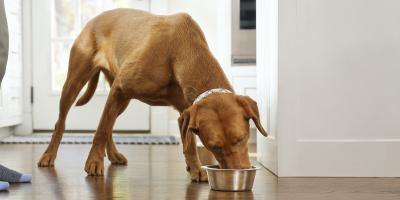Flying With a Dog: Tips, Tricks & What You Should Know


Traveling with dogs can be fun but also stressful for dogs and owners alike, and that can be especially true if you’re flying.
Whether it’s a vacation, a visit to see relatives, or just a quick getaway, it’s essential to prepare and make travel plans well ahead of time. Taking the proper steps can make flying with a dog a safe and enjoyable experience for everyone.
Talk to Your Veterinarian
Before you book a flight with your dog, think about how well you think they might handle the trip. Some pets do not travel well because of medical conditions, age or temperament.
Call or make an appointment with your veterinarian to discuss whether or not they think your dog is healthy enough to fly before you begin to plan your trip and ensure they are up-to-date on all their required vaccinations.
Choose the Right Pet Carrier
The Federal Aviation Agency (FAA) has basic rules and guidelines on domestic flights, but individual airlines may enforce stricter rules at their discretion. Specifically, your in-cabin pet carrier must be small enough to store below the seat in front of you without blocking any person’s path to the main aisle of the airplane.
Also, know which pet carriers are allowed onboard and what the size restrictions are. Most airlines require soft-sided carriers with enough room for your dog to stand up and turn around. The requirements may differ if your dog will travel in the cargo hold.
Many dog carriers will indicate if they are FAA approved, so look for this information when shopping. You’ll still need to verify the carrier you purchase is in accordance with the individual airline’s policy, as well. You don’t want to find out when you’re at the airport that your dog’s carrier isn’t allowed.
Make sure your pet carrier has your contact information on it in case you get separated. It’s also important to ensure your dog’s tags and/or microchip are up-to-date.
Do Your Research
Each airline has its own set of rules when it comes to pet policies; therefore, traveling with a dog requires doing a bit of research in advance. For example, it’s always good to check if your dog’s specific breed is allowed to fly an airline before purchasing a ticket. Flying with a dog breed known for breathing difficulties such as a Pug or a Bulldog may not be allowed on some airlines.
If you’re staying at a hotel or motel, find out if they allow pets and what rules they have for pets staying there. Some places will only allow dogs under a specific size.
Try not to leave your dog alone in your hotel room for too long. If you must leave your dog alone in your room, remember to leave a “Do Not Disturb” sign on the door. You might also want to find out about any dog parks and dog-friendly restaurants in the area before you arrive.
Look up emergency animal hospitals and veterinarians in the area, just in case your dog needs care while you’re traveling.
Before Flying Overseas
Some destinations don’t allow dogs, and some international destinations require dogs to quarantine for a certain amount of time upon arrival. If you’re planning on international travel with your dog, find out each country’s policy and ask yourself if your dog would fare well in a quarantined environment.
Understand the requirements for coming back into the U.S. as well. Note that dogs traveling internationally will likely need a health certificate with a USDA endorsement.
Booking Your Flight
Try booking your flight well in advance, as airlines often limit how many pets are allowed per flight. If you can, book a non-stop flight to avoid having to change planes and adding travel time (and stress) to your dog’s day.
Consider the Possible Temperature on Travel Day
Before booking your flight, especially if you plan on them traveling in the cargo hold, consider the season and know the airline minimum and maximum temperature guidelines for pets. Some airlines won’t even book pets in the cargo hold during certain times of year.
During warm months, select early morning or late evening flight times. In cooler months, choose midday flights. Try to avoid flying with a dog during extreme temperatures.
Travel Day Checklist:
- Give your dog a chance to go to the bathroom before the flight to avoid any in-air accidents
- Feed your dog no later than four hours before your flight to avoid air sickness
- Play with your dog or take them on a long walk to tire them out before the flight
- Ensure your dog is wearing an i.d. tag with up-to-date information
- Make sure your dog’s microchip is up-to-date
- Pack a bag that includes dog food, bowls, medication, a leash and a harness
- If your dog is traveling in the cargo hold, let all airline personnel know (including flight attendants and pilots)
- Always keep a recent photo of your pet with you
- Bring your dog’s health certificate with you, especially when traveling internationally
- Use calming supplements or veterinarian-prescribed medications as needed (and as directed)
Flying With a Large Dog
If you’re traveling with a large breed, they will most likely have to fly as checked baggage or in cargo and not in the main cabin unless they are a service animal. If this is the case, be mindful of the forecasted outside temperatures and try to book a date or time when it’s not too hot or cold. Many airlines will not let dogs travel in the cargo hold if temperatures are below 45º F or above 85º F.
If you plan on checking your dog as baggage or having them fly in cargo, you’ll need a large, International Air Transport Association (IATA)-approved travel crate that must be made from metal, rigid plastic, fiberglass, welded metal mesh, solid wood or plywood. The crate must be the length of your dog (nose to tail), plus half the length of his front length, twice the width of your dog’s shoulder to shoulder width and as tall as your dog is while they’re standing.
Make sure to let the pilot and flight attendants know your dog is in the cargo hold so they can activate the pressurized climate control function to keep your dog as comfortable as possible.
Flying With a Puppy
If you decide to fly with a puppy, remember most airlines require they be at least eight weeks old to board, and you must have proof that they’re fully vaccinated. The first step is to reach out to your veterinarian for advice and see if they think your puppy is okay to fly.
In the weeks leading up to the trip, make sure your puppy is familiar with their travel crate and maybe try a few short car trips to help them get acclimated.
Once onboard, keep in mind that puppies may need to keep themselves occupied more than older dogs, so be sure to bring some dog food, treats and chew toys to keep them entertained. Also, get a travel bowl and an empty water bottle that you can fill after you go through security, so you’ll have water for your puppy in the event of a long or delayed flight. Remember your puppy doesn’t have as much control over their bladder or digestion, so they’ll need more potty breaks.
Get more advice, information and tips for dog owners from our experts on our Pet Expertise page.
Related articles

Reward Yourself with myPurina
Earn and redeem rewards for Purina products with the myPurina app.






